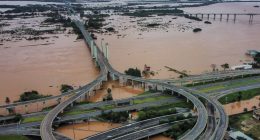
The main concern of journalists covering presidential inaugurations used to be guarding against the January chill.
For the swearing-in of Joseph R. Biden Jr. on Wednesday, some reporters and photographers are taking along protective gear used in combat zones.
Two weeks after a pro-Trump mob stormed the Capitol in a siege that resulted in five deaths, and aware of warnings of extremist violence and the presence of National Guard troops, news organizations have turned to journalists with experience in reporting on conflict zones to cover what is usually a political pageant.
Ron Haviv, a photographer who has covered wars and political violence around the world for three decades, has gone to Washington on assignment for The Intercept. The strangeness of the moment hit him when he was discussing safety precautions with his editors, he said.
“We realized that we had the same conversations about what to do during the uprisings in Libya or Cairo or fighting in Baghdad or coup attempts here or there,” Mr. Haviv said. “All of a sudden, you take a deep breath and realize you’re actually talking about covering the inauguration of the president in Washington, D.C.”
The Nation gave the inauguration assignment to Andrew McCormick, an independent journalist who is a Navy veteran with experience in Afghanistan. Anna Hiatt, the publication’s executive digital editor, said Mr. McCormick had kept his cool while covering the Capitol siege.
“Because he’s ex-military, I have more confidence in his ability to walk into a stressful and dynamic situation and not only be able to see and react when something is really wrong, but to get out when he needs to,” Ms. Hiatt said.
The Committee to Protect Journalists issued a safety advisory detailing risks that could include “potential vehicle ramming of crowds.” Reporters Without Borders put out a similar warning.
CBS and The Associated Press said in statements that they were taking precautions to protect their inauguration reporters, while Reuters said it had “redoubled” its safety efforts before, during and after the presidential election. Time magazine said it was dispatching two of its journalists with conflict experience, Kim Dozier and Simon Shuster, to help cover the event.
The New York Times is sending nearly all of its reporters in Washington to cover the inauguration, and many of them have experience reporting in war zones “given that the national security team and Pentagon correspondents are based in the bureau,” Elisabeth Bumiller, assistant managing editor and Washington bureau chief, said in a statement.
Hugh Brumfitt, the managing director of the British company Insurance For, said he had recently seen “a significant increase” in requests from news outlets for insurance coverage for their journalists.
“What is very interesting is that clients have been extending the coverage for a few days after the inauguration, possibly anticipating further marches,” he wrote in an email.
Richard Hall, the senior U.S. correspondent for the British news site The Independent, covered the Syrian civil war and the Islamic State as a correspondent based in Beirut, Lebanon. Mr. Hall, who will be in Washington for the inauguration, said he planned to stay in constant communication with his colleagues in a WhatsApp group.
“I’m a white man, and I can kind of just blend into the crowd, which is what I did when the Capitol protests were going on,” he said. “I’m fully aware that most journalists and especially photographers and videographers don’t have that privilege.”
Vice News will have security advisers with its journalists, and protective equipment will be available, said Sebastian Walker, the outlet’s Washington bureau chief.
“I’ve covered protests in countries around the world, in the Middle East, in Haiti, and I think it’s actually getting more dangerous to do it here,” Mr. Walker said, “because of the attitude of the people you’re covering.”
Adam Ferguson, a war photographer who spent years in Afghanistan, said it was “unusual and surreal” to be packing a helmet and other protective gear for his first presidential inauguration, which New York Magazine assigned him to cover. But he was not surprised that other journalists with his experience will be in Washington on Wednesday.
“It makes sense to send somebody prepared to be in a situation like that,” he said. “If there’s violence and people whose intention is to harm journalists, then ultimately it’s a combat environment.”
Janine di Giovanni, who spent nearly 30 years reporting on combat and its aftermath in the Middle East, the Balkans and Africa, said on Tuesday that she was weighing whether or not to go to Washington for the inauguration. She added that she had been in touch with fellow war correspondents about finding flak jackets and taping notes about their blood type to their helmets, as she once did to facilitate medical treatment in sniper-ridden Bosnia.
“I’m used to being a war reporter in countries where there were no institutions, or the institutions shattered very rapidly,” said Ms. di Giovanni, now a senior fellow at Yale University’s Jackson Institute for Global Affairs. “This is a country that had, until recently, extremely strong institutions that protected us descending into the abyss, and to see what’s happening now is disturbing beyond belief.”
Source: | This article originally belongs to Nytimes.com








